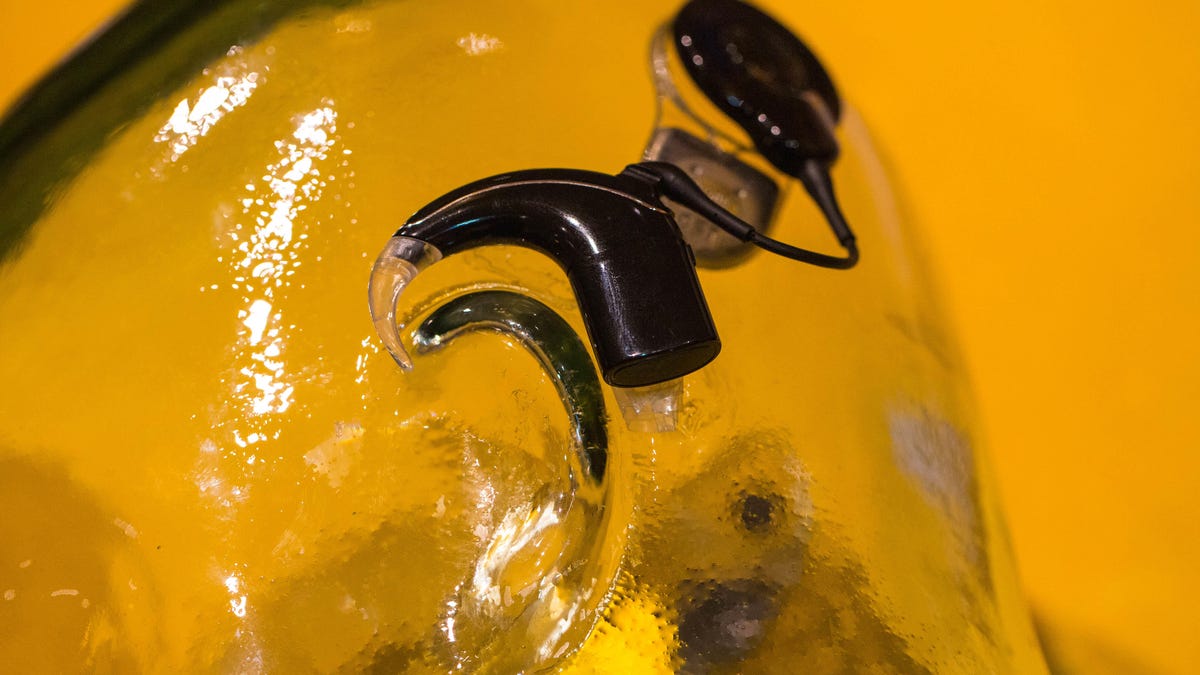 Why You Can Trust CNET
Why You Can Trust CNET Hearing devices feel the vibes, hide in your ear canal at CES 2019
New devices could change the lives of the deaf and hearing impaired, starting at $300.

Though it's not usually something you can buy at your local store, hearing aids and associated devices are nonetheless out in full force here at CES 2019.
There's a device designed to help the deaf experience music at concerts, a truly invisible hearing aid that goes deep in your ear canal and an improved Cochlear "bionic ear."
Hearing loss affects millions of Americans, especially older adults, and two out of three people over 70 have hearing issues. But only 20 percent of adults who have a hearing loss get a hearing aid, according to a report in CBS News. A new law, the Over the Counter Hearing Aid Act signed into law in 2017, is designed to increase access to hearing aid products -- and a big part of that is reducing the price.
Some of the hearing aid products introduced at CES 2019 are still very expensive, but one starts at just $300. Here's a look.
Avnet Music: Not Impossible
A wristband designed to help deaf people "hear" music at concerts
While there are plenty of gadgets that transform sound into vibration, they're mostly designed to enhance games or movies in the home. Avnet's Music: Not Impossible is meant to be worn at music events. The inventors say that the wristband or the vest could be hired out by music venues or artists to the deaf to use. At a suggested cost of around $10 to $15 per concert, the device would then pulse in time with the music.
The company showed footage of a Greta Van Fleet show it had organized where half of the audience was deaf and all people were wearing Music: Not Impossible products. The company said the devices allowed the crowd, deaf and hearing alike, to better experience the concert together.
Eargo Neo
The Eargo Neo is designed to look like you're not wearing a hearing aid.
Eargo's "invisible" hearing aid, the Neo, fits fully inside your ear canal. You cannot see the device even when you're up close to the wearer, which should help people who don't want the potential stigma wearing a hearing aid could bring.
The Neo is good for a full day of use (20 hours) and comes with an AirPod-like case to charge it overnight. To achieve the invisible look, each earpiece features a small cable at the end which a user grips to pull out. The aid comes with three modes of increasing strengths and the user taps each ear to change the mode.
I tried the hearing aid and found it wasn't uncomfortable in the way that some in-ear headphones like Etymotics are for me. I was able to change modes easily, and everything did seem clearer on the lowest settings. However one of my ears picked up more metallic noise from the crowded CES floor than the other.
The only real problem I had was in trying to remove it. In attempting to grab the cable I managed to push the device further in, which was very uncomfortable. "There is a trick to it", the Eargo CEO told me, and after assuring me it wasn't too far in he then fished it out for me with his fingers.
The Eargo is a Class 1 medical device and while it isn't available on insurance the company sells it for $2,750. The company also offers more affordable options from a little over a thousand dollars.
Cochlear Nucleus 7
The Cochlear implant restores hearing to the deaf.
Unlike the other hearing aids I saw, the Cochlear "bionic ear" is an implant. It's obviously not able to be "tried on" as the functioning part of the device wraps around inside your inner ear. Its purpose is to restore hearing to the profoundly deaf. The company introduced me to a woman who had the device implanted and she told me it had changed her life.
The company highlighted the newest Nucleus 7 Sound Processor -- which it says is "the world's first and only Made for iPhone cochlear implant sound processor". Users are able to communicate with the device via their phones over a low-power Bluetooth connection.
The devices aren't cheap, with the implant and associated therapy costing between $40,000 and $100,000 the staff at the Cochlear stand told me, but they added the device is covered under insurance in the US. The company has been offering the technology since it started in Australia in the '70s while the bionic ear has been Stateside for almost 30, Cochlear said.
Starkey Hearing Technologies Livio AI
The Livio AI is the world's first Healthable.
The Livio AI loops over the back of the ear like a normal hearing aid but the main difference is that it has a bunch of sensors onboard. Billed as the world's first Healthable, the Livio AI is able to detect falls and alert the user and/or family if there is no response. It can also do other health tracking such as physical activity and "cognitive health" in social situations. Depending on the users' needs, the hearing aid can cost between $1,000 and $5,000.
Zvox VoiceBud VB20
The Zvox VB20 is available for $300.
While Zvox isn't officially at CES 2019, it is showing off its latest hearing device at a hotel on the Las Vegas Strip. The VoiceBud VB20 hearing device is designed to be discrete, and features an onboard dual-microphone and associated phone app. Its 1-inch-long housing sits behind the ear and is connected to the earpiece by a translucent cable. The onboard battery is good for three to four days of use. The VB20 is available for $300.
CES 2019: See all of CNET's coverage of the year's biggest tech show.
CES schedule: It's six days of jam-packed events. Here's what to expect.

